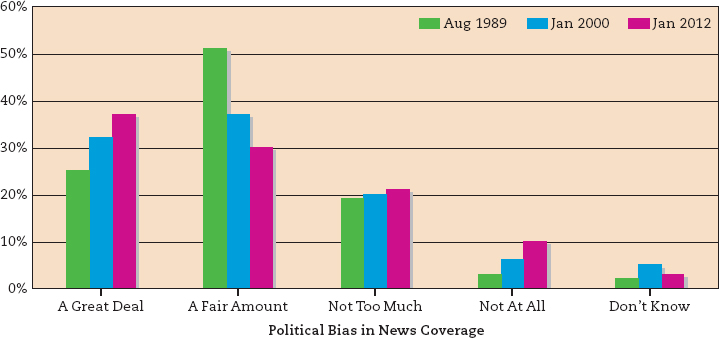Case Study
CASE STUDY
Bias in the News
All news is biased. News, after all, is primarily selective storytelling, not objective science. Editors choose certain events to cover and ignore others; reporters choose particular words or images to use and reject others. The news is also biased in favor of storytelling, drama, and conflict; in favor of telling “two sides of a story”; in favor of powerful and well-connected sources; and in favor of practices that serve journalists’ space and time limits.
In terms of political bias, a 2012 Pew Research Center study reported that 37 percent of Americans see “a great deal of political bias” in the news—up from 31 percent in 2007 and 25 percent back in 1989 (see below). In terms of political party affiliation, 49 percent of Republicans in this 2012 survey reported “a great deal” of bias, while only 32 percent of Democrats and 35 percent of Independents reported high levels of political bias. Since the late 1960s, public perception says that mainstream news media operate mostly with a liberal bias. This would seem to be supported by a 2004 Pew Research Center survey that found that 34 percent of national journalists self-identify as liberal, 7 percent as conservative, and 54 percent as moderate.1
Given primary dictionary definitions of liberal (adj., “favorable to progress or reform, as in political or religious affairs”) and conservative (adj., “disposed to preserve existing conditions, institutions, etc., or to restore traditional ones, and to limit change”), it is not surprising that a high percentage of liberals and moderates gravitate to mainstream journalism.2 A profession that honors documenting change, checking power, and reporting wrongdoing would attract fewer conservatives, who are predisposed to “limit change.” As sociologist Herbert Gans demonstrated in Deciding What’s News, most reporters are socialized into a set of work rituals—especially getting the story first and telling it from “both sides” to achieve a kind of balance.3 In fact, this commitment to political “balance” mandates that if journalists interview someone on the Left, they must also interview someone on the Right. Ultimately, such balancing acts require reporters to take middle-of-the-road or moderate positions.
Still, the “liberal bias” narrative persists. In 2001, Bernard Goldberg, a former producer at CBS News, wrote Bias. Using anecdotes from his days at CBS, he maintained that national news slanted to the Left.4 In 2003, Eric Alterman, a columnist for the Nation, countered with What Liberal Media? Alterman admitted that mainstream news media do reflect more liberal views on social issues but argued that they had become more conservative on politics and economics—displayed in their support for deregulated media and concentrated ownership.5 Alterman says the liberal bias tale persists because conservatives keep repeating it in the major media. Conservative voices have been so successful that one study in Communication Research reported “a fourfold increase over the past dozen years in the number of Americans telling pollsters that they discerned a liberal bias in the news. But a review of the media’s actual ideological content, collected and coded over a 12-year period, offered no corroboration whatever for this view.”6 However, a 2010 study in the Harvard International Journal of Press/Politics reported that both Democratic and Republican leaders are able “to influence perceptions of bias” by attacking the news media.7
Since journalists are primarily storytellers, and not scientists, searching for liberal or conservative bias should not be the main focus of our criticism. Under time and space constraints, most journalists serve the routine practices of their profession, which calls on them to moderate their own political agendas. News reports, then, are always “biased,” given human imperfection in storytelling and in communicating through the lens of language, images, and institutional values. Fully critiquing news stories depends, then, on whether they are fair, represent an issue’s complexity, provide verification and documentation, represent multiple views, and serve democracy. 

Source: Pew Research Center Survey, January 5 - 8, 2012.